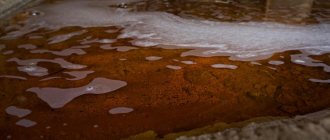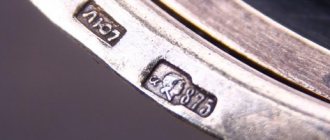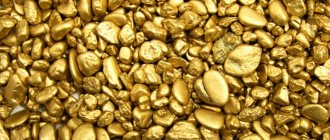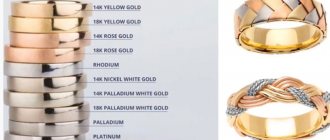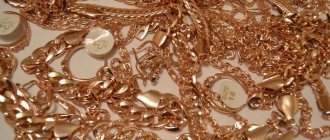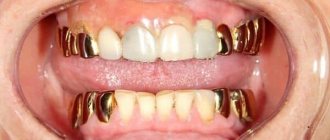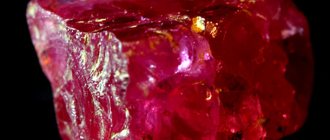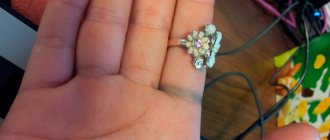| Gold | |
| Atomic number | 79 |
| Appearance of a simple substance | Soft malleable yellow metal |
| Properties of the atom | |
| Atomic mass (molar mass) | 196.96654 a. e.m. (/mol) |
| Atomic radius | 146 |
| Ionization energy (first electron) | 889.3 (9.22) kJ/mol () |
| Electronic configuration | [Xe] 4f14 5d10 6s1 |
| Chemical properties | |
| Covalent radius | 134 |
| Ion radius | (+3e) 85 (+1e) 137 |
| Electronegativity (Pauling) | 2,54 |
| Electrode potential | Au←Au-3 1.50 V Au←Au+ 1.70 V |
| Oxidation states | -3, 1 |
| Thermodynamic properties of a simple substance | |
| Density | 19,3 /³ |
| Molar heat capacity | 25.39[1]/(mol) |
| Thermal conductivity | 318 /(·) |
| Melting temperature | 1337,58 |
| Heat of Melting | 12.68 kJ/mol |
| Boiling temperature | 3080 |
| Heat of vaporization | ~340 kJ/mol |
| Molar volume | 10.2 ³/mol |
| Crystal lattice of a simple substance | |
| Lattice structure | cubic face-centered |
| Lattice parameters | 4,080 |
| c/a ratio | n/a |
| Debye temperature | 170,00 |
| Au | 79 |
| 196,96654 | |
| [Xe]4f145d106s1 | |
| Gold | |
Gold
- an element of a secondary subgroup of the first group, the sixth period of the periodic table of chemical elements, with atomic number 79. Denoted by the symbol Au (Latin Aurum).
The simple substance gold (CAS number: 7440-57-5) is a noble metal of yellow color. Diagram of a gold atom
Proto-Slavic *zolto (Russian gold, Ukrainian gold, Old Slavic gold, Polish złoto) is related to Lit. geltonas "yellow", Latvian. zelts "gold, golden"; with different vocalism: goth. gulþ, German Gold, English gold; further Skt. hiraṇyam, Avest. zaranya "gold", also Skt. hari "yellow, golden, greenish", from the Proto-Indo-European root *ǵʰel- "yellow, green, bright". Hence the names of the colors: yellow, green.
Connection with the root “sun” ( sol
, other Greek ἥλιος) is doubtful.
What is gold
In its pure form, gold is a shiny metal with a bright yellow color. Number 79 of the periodic table, international designation – Aurum (Au). One of the most “massive” but soft metals with a cubic lattice structure centered on the faces.
The name in modern languages goes back to a Proto-Indo-European root meaning “yellow, green, bright.” The Latin name, given in honor of the goddess of the dawn, Aurora, is also translated as “yellow”.
Gold crystals grown by chemical transport
How and where it is mined
Gold is distributed throughout the planet, but unevenly. In Russia, for example, all deposits are concentrated beyond the Urals - in the Far East and Eastern Siberia.
Chukotka, Amur Region, and Krasnoyarsk Territory are especially rich.
Almost always these are rocks that formed in the Precambrian. This period lasted four billion years and ended 539 million years ago. Gold is as old as the Earth.
Almost all reserves are extracted from primary deposits, but placers are not neglected.
Extraction is carried out in several ways, the simplest of which is flushing. Dense gold remains in the sieve with heavy fractions of sand (“slich”), and lighter compounds are washed out. This method is accessible even to novice prospectors. Used on placers.
More complex, industrial methods:
- amalgamation;
- cyanidation
- regeneration.
It is extracted from other metals and ores by refining. Entire factories are being built for this, but amateurs are trying to do the procedure at home.
Receipt
Gold nugget
To obtain gold, its basic physical and chemical properties are used: its presence in nature in a native state, the ability to react with only a few substances (mercury, cyanide). With the development of modern technologies, chemical methods are becoming more popular.
Flushing
The washing method is based on the high density of gold, due to which, in a stream of water, minerals with a density less than gold (and these are almost all minerals of the earth’s crust) are washed away and the metal is concentrated in a heavy fraction, sand consisting of minerals of high density, which is called concentrate. This process is called concentrate washing or grinding. In small volumes it can be done manually using a washing tray. This method has been used since ancient times, and is still used to develop small placer deposits by prospectors, but its main application is to search for deposits of gold, diamonds and other valuable metals.
Flushing is used to develop large placer deposits, but special technical devices are used: dredges and flushing devices. The resulting concentrates, in addition to gold, contain many other dense minerals and the metal is extracted from them, for example, by amalgamation.
All placer gold deposits are developed using the washing method; it is used to a limited extent in primary deposits. To do this, the rock is crushed and then washed. This method cannot be applied to deposits with dispersed gold, where it is so dispersed in the rock that after crushing it does not separate into individual grains and is washed away during washing along with other minerals. Unfortunately, during washing, not only small gold is lost, which is easily washed off from the washing block, but also large nuggets, the hydraulic coarseness of which does not allow them to settle quietly in the cells of the mat. Therefore, on dredges and industrial equipment, be sure to keep an eye out for large rolling debris - these could very well turn out to be nuggets!
This method of extracting gold was historically the first, and it is very cheap because it does not require the construction of expensive factories, and in the case of river sediments, there is no need to crush the rock. It is economically profitable to mine placers with a gold content of more than 0.1 g per 1 cubic meter of loose rock (sand, loam, etc.).
Amalgamation
The amalgamation method is based on the ability of mercury to form alloys - amalgams with various metals, including gold. In this method, moistened crushed rock was mixed with mercury and subjected to additional grinding in mills - running bowls. The amalgam of gold (and associated metals) was removed from the resulting sludge by washing, after which the mercury was distilled from the collected amalgam and reused. The amalgamation method has been known since the 1st century BC. e., acquired the greatest scale in the American colonies of Spain starting from the 16th century: this became possible due to the presence in Spain of a huge mercury deposit - Almaden. At a later time, the method of external amalgamation was used, when crushed gold-bearing rock, during washing, was passed through enrichment sluices lined with copper sheets coated with a thin layer of mercury. The amalgamation method is applicable only in deposits with a high gold content or during its enrichment. It is now used very rarely, mainly by prospectors in Africa and South America.
Cyanidation
Gold dissolves in solutions of hydrocyanic acid and its salts, and this property has given rise to a number of extraction methods by cyanidation of ores.
The cyanidation method is based on the reaction of gold with cyanides in the presence of atmospheric oxygen: crushed gold-bearing rock is treated with a dilute (0.3-0.03%) solution of sodium cyanide, gold from the resulting solution of sodium cyanoaurate Na[Au(CN)2]
deposited either with zinc dust or on special ion exchange resins.
The cyanidation method was initially used in large factories, where the rock was crushed and cyanidation was carried out in special vats. However, the development of technology has led to the emergence of the heap leaching method, which consists of the following: a waterproof platform is prepared, ore is poured onto it and it is irrigated with cyanide solutions, which, seeping through the rock, dissolve the gold. After this, they enter special sorption columns, in which the gold is deposited, and the regenerated solution is sent back to the heap.
The cyanidation method is limited by the mineral composition of the ores; it is not applicable if the ore contains large amounts of sulfides or arsenides, since cyanides react with these minerals. Therefore, cyanidation processes low-sulfide ores or ores from an oxidation zone in which sulfides and arsenides are oxidized by atmospheric oxygen.
Complex multi-stage technologies are used to extract gold from sulfide ores. Gold extracted from deposits contains various impurities, so it is subjected to special highly purified processes that are carried out in refineries.
Regeneration
It is carried out by the action of a 10% alkali solution on solutions of gold salts, followed by the precipitation of refined gold onto aluminum from a hot hydroxide solution.
Physico-chemical characteristics
Aurum is classified as a noble metal (along with silver, platinum and its group metals). They received this name based on their chemical properties: they do not rust, do not oxidize, and do not interact with almost all chemical elements.
| Properties of the atom | |
| Name, symbol, number | Gold / Aurum (Au), 79 |
| Atomic mass (molar mass) | 196.966569(4)[1] a. e.m. (g/mol) |
| Electronic configuration | [Xe] 4f14 5d10 6s1 |
| Atomic radius | 144 pm |
| Chemical properties | |
| Covalent radius | 134 pm |
| Ion radius | (−3e) 185 (+1e) 137 pm |
| Electronegativity | 2.64 (Pauling scale) |
| Electrode potential | Au←Au3+ 1.50 V, Au←Au+ 1.70 V |
| Oxidation states | −1,1,3,5 |
| Ionization energy (first electron) | 889.3 (9.22) kJ/mol (eV) |
| Thermodynamic properties of a simple substance | |
| Density (at normal conditions) | 19.3-19.32[2][3] g/cm³ |
| Melting temperature | 1337.33 K (1064.18 °C, 1947.52 °F)[2] |
| Boiling temperature | 3129 K (2856 °C, 5173 °F)[2] |
| Ud. heat of fusion | 12.68 kJ/mol |
| Ud. heat of vaporization | ~340 kJ/mol |
| Molar heat capacity | 25.39[4] J/(K mol) |
| Molar volume | 10.2 cm³/mol |
| Crystal lattice of a simple substance | |
| Lattice structure | cubic face-centered Cu type, space group Fm3m |
| Lattice parameters | 4.0781 Å |
| c/a ratio | 1 |
| Debye temperature | 170.00 K |
| Other characteristics | |
| Thermal conductivity | (300 K) 318 W/(m K) |
| CAS number | 7440-57-5 |
“Royal vodka”, a composition of high concentration nitric and hydrochloric acids, can dissolve gold.
Alloy metals in alloys with gold and their properties
In ancient times, purer gold was often used, but the size of the coins quickly changed with intensive use (they were worn out), so they began to use a different technique for producing the precious metal. Alloys were added and proportions were selected that would make it possible to create a material with the most suitable characteristics: high value and strength. The properties of the additives were taken into account. List of the most common ones:
- silver for softness: the main advantage of introducing such an alloy is the ability to increase malleability, ductility, in addition, the precious metal acquires a lighter shade, when choosing the right ratio it becomes white, but the more silver, the lower the value of the product;
- copper for a red tint: used for the purpose of alloying with gold, allows you to change the Au strength indicator (products better withstand mechanical loads), as well as its color - the precious metal acquires a red tint, unlike silver, by adding a small proportion of copper (14-15%) will make it red;
- nickel for hardness: it is characterized by increased hardness and resistance to corrosion, which allows the precious metal to be used in dentistry and the jewelry industry, the disadvantage is the risk of developing allergies when products come into contact with the skin;
- palladium for refractoriness: to obtain a material of higher hardness, the chemical formula changes - palladium is added, at the same time the cost of the products increases, since this alloy also belongs to precious metals, and also contributes to a change in color to a lighter (white);
- platinum for whiteness: used to change the color of the alloy; it is enough to increase the platinum content to 8.4% to obtain a white precious metal; in addition, the addition of such an alloy contributes to an increase in the elasticity of gold and the melting point, which somewhat complicates the work with products;
- ruthenium for strength: increases the melting point, as a result, to change the shape of the product you need to heat it more, gold becomes stronger, but ruthenium does not affect its shade;
- iridium for wear resistance: it is not used to produce an alloy of a different color, but is used to change the properties of the precious metal, as a result, gold becomes even more elastic than when combined with iridium, products are much less amenable to processing;
- osmium for elasticity: the alloy in terms of the degree of impact has many properties in common with ruthenium, iridium, when such a metal is introduced into the composition, the melting temperature changes - it increases, working with the material becomes more difficult, but elasticity increases, its resistance to deformation, but will not withstand a pinpoint impact ;
- cadmium for fusibility: unlike osmium, iridium and other alloys, cadmium, on the contrary, reduces the melting point of the gold mixture, which makes it easier to work with; the precious metal becomes more ductile, but at the same time fragile, since it does not always withstand mechanical loads exerted during the operation of the product, in addition, the gold alloy changes color slightly - a greenish tint appears, but there are other alloys to obtain such a tone, cadmium more often performs other tasks;
- zinc for a green tint: its properties are similar to cadmium, it also contributes to the appearance of a green color, but by choosing a suitable base (ligature), this disadvantage can be eliminated; in addition, zinc increases the hardness of the material, but at the same time it is easier to damage it, because it increases degree of fragility, with pinpoint impacts the product can be destroyed, in addition, the ligature helps to reduce the melting point;
- aluminum for plasticity and unusual shades of gold alloys: one of the types of alloys used in the production of various precious metals, aluminum is introduced into the composition of the violet-colored alloy.
Interesting: A superhard metal based on Au and Ti (titanium) was recently invented.
Precious metals and impurities
Gold samples
Aurum is soft, the hardness on the Mohs scale is only 2.5 units. Other properties are required for practical use. To increase the strength of products, others are mixed into the base metal. Such additives are called ligatures.
How much gold is in the alloy and how much is impurities is determined by the sample. This is the most important characteristic that determines the purity of the alloy, and with it the cost.
It is applied to the product by the manufacturer in the form of a marking called an assay mark.
Today, classification is carried out according to two systems - metric and carat:
- The metric system shows how many milligrams of pure gold are contained in 1 gram of the alloy.
- According to the British karat system, the weight of the product is divided into 24 parts, and the number with the letter K shows how many of these parts are gold.
Comparison of the specified sample systems:
| Metric | 375 | 500 | 585 (583) | 750 | 958 | 999 |
| Carat | 9 | 12 | 14 | 18 | 23 | 24 |
The first is used by Russia, other CIS and Baltic countries. The second is the USA, Europe, the countries of the British Commonwealth.
Carat for gold and precious stones are different concepts and units. They are designated respectively: K and ct.
Sample system
In all countries, the amount of gold in alloys is controlled by the state. In Russia, five standards of gold jewelry alloys are generally accepted: gold 375, 500, 585, 750, 958.
- 375 sample. The main components are silver and copper, gold - 38%. A negative property is that it fades in air (mainly due to the formation of silver sulfide Ag2S). 375 gold has a color range from yellow to red.
- 500 sample. The main components are silver and copper, gold - 50.5%. Negative properties - low castability, color dependence on silver content.
- 585 sample. The main components are silver, copper, palladium, nickel, gold - 58.5%. The fineness is quite high, this determines the numerous positive qualities of the alloy: hardness, strength, stability in air. Widely used for making jewelry.
- 750 sample. The main components are silver, platinum, copper, palladium, nickel, gold - 75.0%. Positive properties: susceptibility to polishing, hardness, strength, easy to process. The color range ranges from green through bright yellow to pink and red. Used in jewelry, especially for filigree work.
- 958 sample. Contains up to 96.3% pure gold. Rarely used, since the alloy of this sample is a very soft material that does not hold polish and is characterized by unsaturated color.
- 999 sample. Pure gold.
All alloys above 750 standard do not tarnish in air.
PHYSICAL PROPERTIES
| Mineral color | rich yellow, fading to white-yellow with a predominance of silver |
| Stroke color | brilliant yellow |
| Transparency | opaque |
| Shine | metal |
| Cleavage | No |
| Hardness (Mohs scale) | 2,5-3 |
| Strength | malleable |
| Kink | jagged |
| Density (measured) | 15 – 19.3 g/cm3 |
| Radioactivity (GRapi) | 0 |
| Magnetism | diamagnetic |
Types of gold
The classic version of the noble metal is sunny yellow.
To diversify the assortment, variants of different shades are created for the jewelry industry. For this purpose, the base metal workpiece is “diluted” with impurities. At the same time, they impart strength to the alloy.
There are several common types of gold.
White
The second most common type of metal.
Compound (%):
- gold – 58.5;
- copper – 21;
- nickel (manganese) – 12.6;
- zinc – 7.9.
The problematic component of the composition is nickel. This is an allergen, in modern products it is replaced by manganese, platinum or palladium.
Green
Initially, green gold was called electrum - an alloy of native gold with silver (which quantitatively prevailed). Today, gold is the leader in jewelry – 73%.
Red, pink
Copper gives the metal a reddish tint.
The final shade depends on its amount in the gold alloy:
- 25% – pink;
- 50% – red.
These types are the most popular among jewelers, since copper makes products stronger and cheaper.
Exotic
The combination of aurum with rare or uncharacteristic metals for industry creates samples of unusual shades:
| Alloy color | Gold (%) | Ligature (type, %) |
| Black | 75 | Kobalt, 25 |
| Blue | 46 | Indium, 54 |
| Violet | 80 | Aluminum, 20 |
Such products are more expensive than classic designs.
Product care
To avoid damage to products, you must:
- Remove jewelry before cleaning, washing dishes, or visiting a bathhouse or sauna.
- Store products in a special case or fabric bag.
- At the end of each day, remove jewelry and wipe it with a dry cloth or napkin.
- Protect the product from contact with cosmetics and perfume.
If you need to clean gold from plaque or darkening, you can use home methods, specialized cleaning products, or take the jewelry to a specialized workshop.
Gold is a precious metal used in various fields of activity. Its popularity is explained by its attractive appearance, properties, and technical characteristics. By adding other metals, the characteristics and properties of the alloy can be changed.
Where is it used?
For centuries, the gold metal has been used as a material for coins and jewelry. This is a status material from which royal and imperial crowns, crowns, and other attributes of power were made. History knows golden thrones.
Today, extracted raw materials are distributed in the following areas (%):
- jewelry – 40;
- reserves of national central banks and international financial organizations – 25;
- investment accounts – 25;
- industry, medicine - 5 each.
Gold coins were in use as a means of payment until the First World War (1914). They exchanged any paper bill for them.
Jewelry
Gold is the number one material for the upper price segment in jewelry. In jewelry, it is magnificent on its own and as a setting for precious stones.
Investment
Precious metal is a proven object for preserving and increasing capital.
Every country has a gold reserve. In Russia it is measured in thousands of tons.
Ordinary citizens are trying to create a family “pot”:
- Traditionally, people invest in bank bullion or bullion coins.
- In the jewelry segment, items with an unusual provenance (history) or authorship of famous brands are recognized as investment objects.
If we are talking about a mass-produced ring, necklace, or brooch, products of simple shapes are considered reasonable investments. When taking it to a pawnshop or selling it, the loss in value will be minimal. In such situations, even the most intricate gold jewelry is assessed as scrap for recycling. Accepted by weight at the so-called “technical” price.
Gold bars
The largest gold reserves in the world (as of 2018).
| № | Country/organization | Gold (tons) | Share of gold in the total volume of foreign exchange reserves of the state (%) |
| 1 | USA | 8133,5 | 74,5 % |
| 2 | Germany | 3369,9 | 69,6 % |
| 3 | International Monetary Fund | 2814,0 | — |
| 4 | Italy | 2451,8 | 66,6 % |
| 5 | France | 2436,0 | 62,4 % |
| 6 | Russia | 2170,0 | 18 % |
| 7 | China | 1842,6 | 2,3 % |
| 8 | Switzerland | 1040,0 | 5,2 % |
| 9 | Japan | 765,2 | 2,5 % |
| 10 | Netherlands | 612,5 | 67,3 % |
Medicine
Pharmacologically, aurum compounds are used in the manufacture of medications for the treatment of rheumatoid arthritis, tuberculosis, and other ailments. The radioactive isotope of the metal is used by oncologists.
Priorities have changed when using noble metals in dentistry. Until the mid-twentieth century, it was considered prestigious to have gold teeth (crowns). But today the precious metal is being replaced by metal-ceramics and other new materials. But those who want to look young “sew” gold threads under the skin.
Industry
Gold raw materials are indispensable in industry. So, for radio electronics it is a soldering material. It covers the mirrors of telescopes to ensure long-distance communications and is used in advanced industries, including nanotechnology.
The noble metal has even found use in cooking. Confectioners decorate finished products with it.
Food additive E175 is edible gold.
Scientists managed to obtain aurum from mercury by knocking out “extra” atoms. The alchemists' dream came true, but the cost of the final product exceeded the market price by orders of magnitude.
Application
The properties of the precious metal (corrosion resistance, ductility, malleability) have found a place for it in human life:
- Industry, mainly electronics. Tablets, phones, computers cannot be made without precious metals. This industry sector consumes more and more precious metals every year.
- Dentistry. Dentures and crowns are still in demand. Although consumption here is declining, more modern and reliable materials have appeared.
- Pharmacology. Preparations containing gold are used in the treatment of tuberculosis, lupus erythematosus, and rheumatoid arthritis. Metal isotopes began to be used in the treatment of oncology. Research shows that radioactive gold may help treat AIDS.
- Food industry. Those who want to try coffee, beer, or chocolate with gold flakes can already do so. Gold is officially registered as a food additive. Remember, don’t confuse it - this is E175.
- Jewelry absorbs the lion's share of the yellow metal's production.
Gold ring with sital
Interesting: the British Medical Journal published the results of a study of the remains of Diana de Poitiers, the favorite of King Henry II of France. At 60, she looked like she was 30. The reason (according to the researchers’ conclusion) is the amount of gold contained in the bones and hair of the favorite’s remains. It exceeded the norm tens of times. Diana took elixirs with precious metal, which were brought to her from Egypt.
Imitations
They have been able to counterfeit status metal since the times of the Egyptian pharaohs. It was not difficult: gold is too similar to other metals and ores. For example, pyrite is applied to an ornamental stone. The Spanish conquistadors took it from the Indians, believing it to be gold. Prospectors from the Alaska Gold Rush fell into the same trap.
It’s not for nothing that pyrite came to be called “fool’s gold.”
More noble options: electron (an alloy of aurum with silver) and polyxene (platinum plus other components that give the alloy a golden appearance).
The following types of “gold” have been created by man:
- French – copper + tin + zinc.
- Abyssinian – copper + zinc + aurum (0.5%).
- German (goldin) – copper + aluminum.
There are other types of brass-based counterfeits: tombak, pinchback, and others.
It is impossible to distinguish such a fake on your own. Home methods - exposure to iodine, testing with a lapis pencil - allow you to identify the origin of only the surface layer.
Testing for magnetism does not always help either.
Therefore, you should buy gold jewelry from trusted sellers and not immediately tear off the tag with the seal. You can take the item to a jeweler or pawn shop for further inspection.
ORIGIN
Gold products
Native gold is the main form of gold found in nature. It concentrates in hydrothermal deposits forming gold ores, unevenly distributed in fractured vein quartz and in sulfides - pyrite, arsenopyrite, pyrrhotite, etc. In essentially sulfide ores, native gold is finely dispersed. During the oxidation of ores on the earth's surface, fine native gold is partially dissolved and redeposited; in some cases it enriches the upper parts of ore bodies. The processes of their destruction lead to the release of particles of native gold and their accumulation in placers; moving with water flows together with other plastic material, the particles become rounded, rounded, deformed, and partially recrystallized; As a result of electrochemical corrosion, a thin shell of high-fine gold is formed on them, which leads to a general increase in the standard of native gold in placers.
Price
Noble metal is always dear. Today its value is determined on the stock exchange. There, the units of measurement for elite goods are the troy ounce (denoted as oz) and gram (g).
A troy ounce is 31.1 g. About the same as a gold cube with an edge of just under 1.5 cm.
The price of the gold metal is constantly changing, depending on the state of the economy. If it is “stormy”, it goes up in price. In calm times, business people prefer other financial instruments.
However, noble aurum is a profitable long-term investment. In 20 years, since the beginning of the millennium, it has risen in price sevenfold - from $300 to $2000 per ounce.
Precious metals - into coins
The power of gold over a person was fully demonstrated when, from a luxury item, the “despicable metal” became a measure of the value of a product—money. The Lydians were the first to think of making coins from gold.
The last Lydian king Croesus (remember, of course - “rich as Croesus”) came up with a bimetallic (gold-silver) system. The idea was so successful that it lived and flourished for many centuries.
We recommend: MANGANESE - the dream of steelworkers
Darius, the Persian king, began to mint his own image on coins instead of a stamp.
The monetary standard between gold and silver was often 1:10. But the ratios were constantly changing. In Ancient Egypt, silver was more expensive than gold.
How much gold is in a ring
States strictly control purity measures, that is, the content of precious metals, in alloys.
A sampling system has been developed for this purpose. This is the determination of the amount of pure metal in an alloy. This quantity (sample) is called a stamp.
Important: in Russia, alloys containing more than 30% precious metal must be hallmarked.
There are 4 sample systems. The most popular are carat and metric.
The metric system is adopted in countries that have signed the Convention on the Hallmarking of Precious Metals. These are Russia, France, Germany, Israel, Cyprus and several other countries.
The British karate system is preferred in Canada, Switzerland, and the USA. The Irish wisely put both standards on the product - carat and metric. And the UK sets the metric standard, but also indicates the carat standard in the product description.
Informative: if you want to convert carats into a metric standard, multiply the number of carats by 125 and divide by 3. That is, an 18-karat product will correspond to a 750 standard (18x125:3).
Let's recalculate the metric hallmark into carats - multiply the metric hallmark by 24 and divide by 1000. That is, a product with a hallmark of 750 will correspond to 18 carats.
